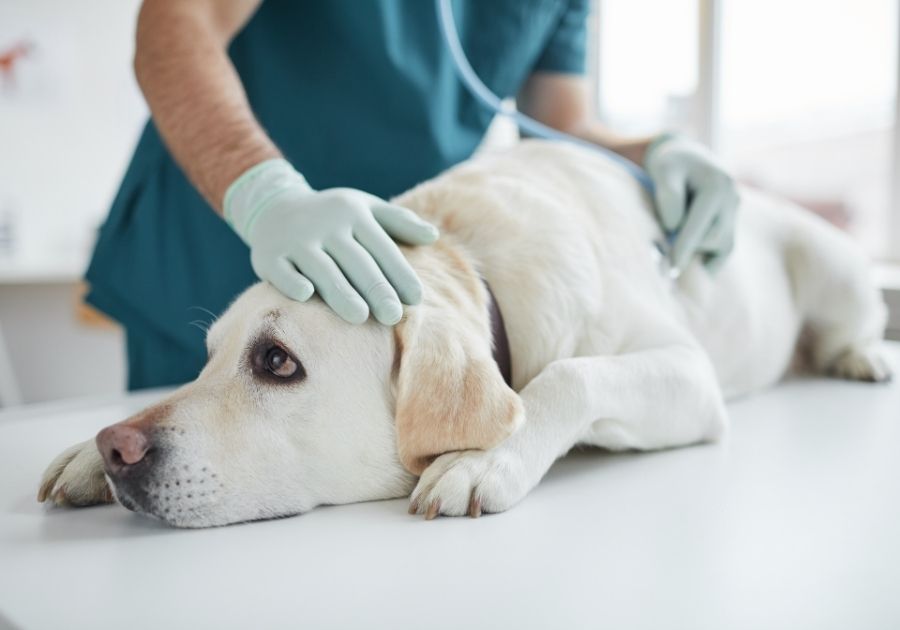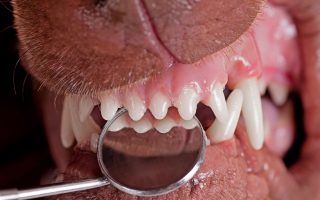Being a caring pet parent entails keeping your dog safe and healthy.
However, the inevitable reality of health problems tags along with the responsibility of assisting your beloved furry companion when it is afflicted.
Sadly, there’s little you can do when your dog is experiencing a seizure. That’s why you feel that dampening sense of ineptness when you’re faced with this situation.
According to reports, one in twenty dogs may experience a seizure in their lifetime. [1]
Therefore, it is vital to know what toxins can cause seizures in dogs, types, symptoms, and treatment.
There are several causes of seizures in dogs ranging from strokes and head injury to toxicity.
Toxicity — a disheartening cause of seizures in dogs, will headline this article, but let’s first understand what seizures are and their causes.
What Are The Causes Of Seizures In Dogs?
Toxicity isn’t the only culprit of dog seizures. Liver and kidney disease, low or high blood sugar, head injury, strokes, brain cancer, encephalitis, and anemia are common issues that result in seizures.
Dog seizures are characterized by loss of consciousness, collapsing, jerking, muscle twitching, stiffening, tongue chewing, drooling, or foaming at the mouth.
Pooping and peeing may occur, followed by disorientation or temporary blindness in extreme cases.
These unconscious behaviors are triggered by intense bursts of electrical activity in the brain, resulting in a seizure.
Reactive seizures triggered by toxin exposure and metabolic disorders might not be the leading cause of dog seizures.
Annually, the ASPCA screens about 200,000 potential pet poisoning cases in the United States. [2]
There are several toxins that might cause dog seizures, ranging from salt ingestion, smoke inhalation, or poisonous plants.
What Toxins Can Cause Seizures In Dogs?
Foods
According to a study, about twenty percent of dogs presented to veterinary hospitals showed symptoms of food poisoning after feeding on old eggs, moldy cheese, and spoiled gravy. [3]
You dog is at risk of seizure if it ingests foods containing substances like theobromine, methylxanthines, xylitol and salt.
Theobromine and Methylxanthines

Caffeine and dark chocolate contain theobromine and methylxanthines, dangerous chemicals that cause muscle tremors and seizures in some dogs if taken in large amounts.
Theobromine and methylxanthines molecules attach themselves to cell receptors, blocking canine-produced compounds that should be there.
it is best never to give your dog chocolate, caffeine, or any food containing these harmful substances, as they can sicken or, in worst cases, result to death.
Xylitol
Xylitol isn’t any better. While this sugar alcohol found in sweeteners is safe for humans, it can cause seizures, hypoglycemia, liver failure, or even death in dogs regardless of the quantity taken. [4]
Xylitol triggers a rapid release of insulin from your dog’s pancreas, leading to a dreadful drop in blood sugar 10 to 60 minutes after ingestion.
While you might avoid artificial foods that outline xylitol as one of their ingredients, berries, plums, corn, oats, mushrooms, lettuce, plants, and some other fruits also contain xylitol.
These foods are best avoided to be safe rather than sorry.
Recommended:
Can Dogs Eat Jelly? Is Jelly Bad For Dogs?
Salt
Your dog might be exposed to toxins from salt ingestion. Salt poisoning from excessive seawater, table salt, or even play-dough might trigger seizures, resulting from toxins. [5]
Hypernatremia, a condition of excessive salt in the blood, can cause muscle stiffness, weakness, shaking, and jerking.
Also, extreme cases of salt poisoning can lead to convulsions, coma, and death due to neurological complications.
Your dog’s body indeed needs salt, but excessive intake can cause poisoning, leading to serious health complications or fatalities.
Garlic and Onions
While you enjoy your homemade delicacies or fast food treats, your dog’s wide and dreamy eyes might tempt you to toss him a handful.
Unfortunately, such a decision can put your dog between the devil and the deep blue sea as such dishes may contain toxic ingredients or seasonings like garlic and onions.
Home & Garden Products

Some household products contain toxins like zinc phosphide and metaldehyde, resulting in muscle tremors, paralysis, impaired movement, and seizures.
Your dog might inhale toxic substances like formaldehyde from new home furnishings, household cleaners, and some construction materials.
Household products and other chemicals are known to cause reactive canine seizures. They include:
- Insecticides, pesticides, and herbicides
- Cleaners
- Antifreeze and de-icing salts
- Toothpaste and mouthwash
- Hand sanitizers
- Lawn fertilizers, and other chemicals can cause reactive seizures.
Medications

We’ve read, heard, and learned so much about the dangers of drug abuse to humans.
It’s similar with dogs; several medications and drugs like analgesics, theophylline, antidepressants, decongestants are known to cause life-threatening seizures and tremors, increased blood pressure, rapid heart rate, and excessive salivation, amongst others.
Scientists say that a dog’s body absorbs human drugs faster and metabolizes them slower, leading to health complications like seizures, stomach ulcers, and kidney failure.
Toxin ingestion from medications can be successfully managed with early treatment but must be carried out under the supervision of a veterinarian.
Below are some of the most dangerous drugs for dogs. Do well to prioritize keeping these human medications that can cause poisoning in dogs away from the reach of your pooch. [6]
- Ibuprofen
- Xanax
- Naproxen
- Aspirin
- Indomethacin
- Acetaminophen
- Ambien
- Adderall
- Beta Blockers
- ACE inhibitors
- Metronidazole
- Diphenhydramine
- Ivermectin
- Procaine Penicillin G
- Fluorouracil (5-FU) cream
Carbon Monoxide
The damage carbon monoxide causes to the body cannot be swept under the carpet.
From lethargy, sudden vomiting, unconsciousness, difficulty breathing, and seizures, carbon monoxide poisoning can lead to ghastly or even fatal reactions.
The colorless, odorless gas might not often make the headlines but can cause death within an enclosed space in fifteen minutes.
Why?
Carbon monoxide reduces oxygen delivery to the body, including the brain, by binding to the oxygen-carrying component of the red blood cells once it’s absorbed into the bloodstream, resulting in cognitive impairment and even death.
Some culprits of carbon monoxide poisoning include:
- Furnaces and ovens
- Automobile exhaust
- Kerosene lamps
- Gas water heaters
- Barbecue grills
- Slow gas leaks
- Smoke inhalation in areas of poor ventilation
Therefore, help your dog avoid these places where you both can be exposed to dangerous levels of carbon monoxide.
However, if you suspect your dog has been exposed to carbon monoxide, you should immediately move it to an open space with fresh air.
Animal Compounds
The ecosystem is designed such that some organisms pose significant risks to others.
While your dog might seem the culprit to smaller mammals like rabbits and other rodents, it’s a victim to animals like killer bees and bufo toads.
Most cases of bee stings end in injuries, redness, and swelling, but dogs with anaphylaxis (severe allergic reaction from a sting) can suffer much worse.
Dogs with anaphylaxis may develop seizures, trouble breathing, bruising, and collapse from bee stings.
Fatalities might also be reported in rare cases if the dog reacts to an apid or vespid sting or is stung too often.
Heavy Metals
Heavy metals like lead and zinc are culprits regarding toxicity in dogs, resulting in seizures and other neurological and gastrointestinal impairments, including disorientation and loss of muscle coordination.
Your pooch takes in large amounts of metals by coming in contact with metal-containing substances like:
- Plumbing materials
- Paint
- Soldering lead
- Lead foil
- Golf balls
- Heavy metal ingestion by drinking water from lead pipes or eating from improperly glazed ceramic bowls.
Plants

Like animals, plants are biological causes of seizures in dogs. Some of thee poisonous plants that contain toxins that can cause dog seizures include:
- Wild Mushrooms
- Sago Palm
- Rhododendron
- Lily of the Valley
- Cyclamen
- Brunfelsia
Flowers look and smell good, inspiring, relaxing walks during spring, but they could be dangerous to our dogs if we aren’t careful.
It’s best to walk your dog with a leash around its neck in parks and gardens, restricting it from sniffing flowers that catch its attention.
For example, Rhododendron is a beautiful flower that contains grayanotoxin, a resin that binds to sodium channels, modifying it to cause digestive, respiratory, and neurological issues.
Cyclamen is beautiful too, but its tubers are potentially dangerous to dogs, containing a saponin that can damage red blood cells.
Ingesting Cyclamen tubers can cause digestive problems, heart rhythm abnormalities, and seizures.
Lilly of the Valley is a flowering plant with sweetly scented, bell-shaped, white flowers that crown the spring sensation. It contains cardiac glycoside, a sugar that affects cardiac muscle contraction. [7]
Depending on which part of the plant was ingested, symptoms can range from heart rhythm abnormalities, digestive problems, and possibly seizures. As little as two bulbs can be a lethal dose to your dog.
In fact, by the time you start noticing symptoms in your pooch, it may already be too late.
Therefore, you should not take chances whenever your dog has a cause to come in contact with this plant.
What Are Dog Seizure Symptoms?

Here are the most common signs of dogs having seizures:
- Stiffening
- Drooling
- Collapsing
- Loss of consciousness
- Foaming at the mouth
- Involuntary urinating or defecating
- Tongue chewing or chomping
- Jerking body movements
- Muscle Twitching
- Paddling motions with legs
What Can I Do If My Dog Has A Toxic Seizure?
No doubt, witnessing your dog experiencing a seizure, you feel a dampening sense of ineptness since your ability to restore it to consciousness is limited.
However, there are a few things you can do to help keep your dog safe.
- Panicking disorients you. Therefore, try to comport yourself and stay calm.
- Pull your dog away from stairs and dangerous objects that could hurt them, like furniture, especially shelves, stands, and tables where breakable objects are placed.
- While trying to keep your pooch safe, stay away from its head and mouth as it could bite you in its subconscious state. Your dog might get back to consciousness in fear; as such, it might try to hide and may snap at things.
- Don’t put anything in their mouth since dogs don’t choke on their tongues like humans.
- Keep track of time as prolonged seizures may cause a hike in body temperature. Help regulate your dog’s body temperature by fanning it and sprinkling cold water on its paws.
- While you should restrain from cuddling or touching your dog immediately after the seizure, you may softly talk to it to calm it down.
If your dog is experiencing a seizure for the first time, visit your vet immediately after the seizure ends to determine the cause of the seizure, as not all canine seizures are caused by toxin ingestion.
Nevertheless, contact your vet or take your dog to them if it has experienced prolonged or multiple seizures.
Your pooch risks difficulty breathing and even brain damage as its body temperature rises.
What Are the Types of Seizures in Dogs?
All seizures are not the same; their causes, symptoms, and impact area in the brain differ.
There are four types of seizures:
- Generalized Seizures: This is characterized by unconsciousness and convulsion due to an abnormal electrical activity throughout the brain. Also called grand mal seizure, it lasts between seconds and a few minutes.
- Focal Seizure: Sometimes, generalized seizures are upgrades of focal seizures, which affects some part of the brain, resulting in unusual movements in one side of the body.
- Psychomotor Seizures: These are symptomized by tail-chasing or sudden attacks on imaginary objects for a short period. A psychomotor seizure may be difficult to diagnose (mistaken for playfulness), but odd repetitive behaviors might indicate this neurological disorder.
- Idiopathic Epilepsy: This is characterized by recurrent seizures and is the leading type of seizure in dogs. However, it is known to have no cause and is mainly regarded as genetic.
Dog Seizure Treatment

A veterinary neurologist is in the best position to diagnose the cause of your dog’s seizure and administer treatment.
Blood tests, MRIs, and neurological examinations are common methods used to determine toxin ingestion, metabolic disorders, or infections. Hospitalization can also be recommended to treat underlying causes.
Prolonged or multiple seizures that result in an emergency drive to your vet might result in Diazepam or Midazolam injection to stop an active seizure.
While your dog might be on anticonvulsant medication, every medication has different boons and banes, and no medication is best.
Your vet chooses which medication applies to your dog’s condition based on its diagnosis results, lifestyle, and seizure history.
Frequently Asked Questions
Why would a dog suddenly start having seizures?
Dog seizures have so many causes. Idiopathic epilepsy is the most common, but brain tumors, traumas, toxin ingestion, kidney and liver diseases, head injuries, and strokes can cause sudden seizures in dogs.
Can dehydration cause seizures in dogs?
Dehydration causes kidney damage, a known cause of dog seizures. Moreover, extreme cases of dehydration are symptomized by shock, including collapse and even seizures.
Can electrolyte imbalance in dogs cause seizures?
Electrolyte imbalances, including strong bursts of electrical activity in a dog’s brain, are usually the sole presenting symptom of a neurologic malfunction or seizure.
What are the symptoms of toxicity in dogs?
Aside from seizures, other symptoms of toxicity in dogs include tremors, diarrhea, kidney failure, heart problems, agitation, and nausea.
Can seizures in dogs be cured?
Seizures resulting from idiopathic epilepsy cannot be cured. The dog might be placed on a long-term antiepileptic drug (AED) therapy, perhaps, for the rest of its life.
The Bottom Line: Keep Your Dog Safe
Any dog can experience a seizure, but your dog can be one of the lucky ones that wouldn’t experience any seizure in their lifetime if you watch out for toxins that can cause seizures.
Carefully examine any food and medication you give your dog and take away any spoilt food.
Beware of smoke, plants, animal compounds, household products, and heavy metals within their reach.
It will help if you store toxic home products in inaccessible areas out of the reach of your pets.
New furniture and fabrics should be washed or left outdoor to off-gas for some days to avoid potential hazards they might cause your dog.
Sometimes, ignorance or a little slack in consciousness might result in your pooch munching on potentially dangerous foods.
If you believe your dog has consumed something that could poison it, this is considered an emergency situation.
Here are quick actions you can take:
- Contact the Animal Poison Control Center (APCC) at (888) 426-4435
- Contact the Pet Poison Helpline at (855) 764-7661
- Visit your veterinarian
You May Also Like:
Why Is My Dog Dry Heaving? Causes, Symptoms, Solutions
References & Notes
- Metropolitan Veterinary Associates: “Dog Seizure Signs”
- Humane Society of Northeast Georgia: “National Poison Prevention Week”
- AKC: “Can Dogs Get Food Poisoning?”
- FDA: “Paws Off Xylitol; It’s Dangerous for Dogs”
- American College of Veterinary Pharmacists: “Salt”
- AKC: “My Dog Ate My Pills! 10 Most Dangerous Human Medications for Pets”
- Wag!: “Lily of the Valley Poisoning in Dogs”
Featured: Capuski / Getty Images







